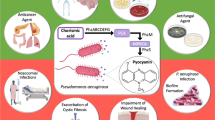Summary
This study was designed to analyze the effect of the mitochondrial respiratory pathways of Candida albicans (C. albicans) on the biofilm formation. The 2, 3-bis (2-methoxy- 4-nitro-5-sulfophenyl)-2H-tetrazolium-5-carboxanilide (XTT) reduction assay was used to measure the metabolic activities of biofilms formed by the C. albicans which were cultured in the presence of respiratory pathways inhibitors. The biofilms formed by the wide type (WT), GOA7-deleted (GOA31), GOAV-reconstituted (GOA32), AOXla-deleted (AOX1) and AOXlb-deleted (AOX2) C. albicans strains were examined by the XTT reduction assay and fluorescence microscopy. The expression of adhesion-related genes BCR1, ALS1, ALS3, ECE1 and HWP1 in the biofilms formed by the above five C. albicans strains was detected by real time polymerase chain reaction. It was found that the metabolic activity of biofilms formed by C. albicans was decreased in the presence of alternative oxidase inhibitor whereas it was increased in the presence of classical mitochondrial respiratory pathway complex HI or complex IV inhibitor. AOX1 strain produced scarce biofilms interspersed with few hyphal filaments. Moreover, no significant changes in the expression of BCR1 and ALS3 were observed in the AOX1 strain, but the expression of ALSI and ECE1 was down-regulated, and that of HWP1 was up-regulated. These results indicate that both AOX1 and AOX2 can promote the biofilm formation. However, AOXla primarily plays a regulatory role in biofilm formation in the absence of inducers where the promoting effect is mainly achieved by promoting mycelial formation.
Similar content being viewed by others
References
Wisplinghofif H, Bischoff T, Tallent SM, et al. Nosocomial bloodstream in US hospitals: analysis of 24,179 cases from a prospective nationwide surveillance study. Clin Infect Sis, 2004,39(3):309–317
Douglas LJ. Candida biofilms and their role in infection. Trends Microbiol, 2003,ll(1):30–36
Chandra J, Kuhn DM, Mukheijee PK, et al. Biofilm formation by the fungal pathogen Candida albicans: development, architecture, and drug resistance. J Bacteriol, 2001,183(18):5385–5394
Cuéllar-Cruz M, López-Romero E, Villagómez-Castro JC, et al. Candida species: new insights into biofilm formation. Future Microbiol, 2012,7(6):755–771
Ramage G, Sabille SP, Thomas DP, et al. Candida biofilms: an update. Eukaryot Cell, 2005,4(4):633–638
Nobile CJ, Mitchell AP. Genetics and genomics of Candida albicans biofilm formation. Cell Microbiol, 2006,8(9): 1382–1391
Nobile CJ, Andes DR, Nett JE, et al. Critical role of Bcrl-depedent adhesins in C. albicans biofilm formation in vitro and in vivo. PloS Pathog, 2006,2(7):e63
Nobile CJ, Mitchell AP. Regulation of cellsurface genes and biofilm formation by the C. albicans transcription factor Bcrlp. Curr Biol, 2005,15(12): 1150–1155
Heimerhorst EJ, Stan M, Murphy MP, et al. The concomitant expression and availability of conventional and alternative, cyanide-insensitive, respiratory pathways in Candida albicans. Mitochondrion, 2005,5(3):200–211
Huh WK, Kang SQ. Characterization of the gene family encoding alternative oxidase from Candida albicans. Biochem J, 2001,1356(Pt2):595–604
Ruy F, Vercesi AE, Kowaltowski AJ. Inhibition of specific electron transport pathways leads to oxidative stress and decreased Candida albicans proliferation. J Bioenerg Biomembr, 2006,38(2):129–135
Yan L, Li M, Cao Y, et al. The alternative oxidase of Candida albicans causes reduced fluconazole susceptibility. JAntimicrob Chemother, 2009,6(4):764–773
Missall TA, Lodge JK, McEwen JE. Mechanisms of resistance to oxidative and nitrosative stress: implications for fungal survival in mammalian hosts. Eukaryot Cell, 2004,3(4):835–846
Konno N, Ishii M, Naqai A, et al. Mechanism of Candida albicans transformation in response to changes of pH. Biol Pharm Bull, 2006,29(5):923–926
Bambach A, Fernandes MP, Ghosh A, et al. Goalp of Candida albicans localizes to the mitochondria during stress and is required for mitochondrial function and virulence. Eukaiyot Cell, 2009,8(11):1706–1720
Li D, Chen H, Florentino A, et al. Enzymatic dysfunction of mitochondrial complex I of the Candida albicans goal mutant is associated with increased reactive oxidants and cell death. Eukaryot Cell, 2011,10(5):672–682
She X, Zhang L, Chen H, et al. Cell surface changes in the Candida albicans mitochondrial mutant goal A are associated with reduced recognition by innate immune cells. Cell Microbiol, 2013,15(9):1572–1584
Pierce CG, Lopez-Ribot JL. Candidiasis drug discovery and development: new approaches targeting virulence for discovering and identigying new drugs. Expert Opin Drug Discov, 2013,8(9):1117–1126
Nobile CJ, Schneider HA, Nett JE, et al. Complementary adhesin function in C. albicans biofilm formation. Curr Biol, 2008,18(14):1017–1024
Author information
Authors and Affiliations
Corresponding author
Additional information
This study was supported by the National Natural Science Foundation of China (No. 81371785).
Rights and permissions
About this article
Cite this article
Wang, Tm., Xie, Xh., Li, K. et al. Alternative Oxidase Promotes Biofilm Formation of Candida albicans. CURR MED SCI 38, 443–448 (2018). https://doi.org/10.1007/s11596-018-1898-x
Received:
Revised:
Published:
Issue Date:
DOI: https://doi.org/10.1007/s11596-018-1898-x




